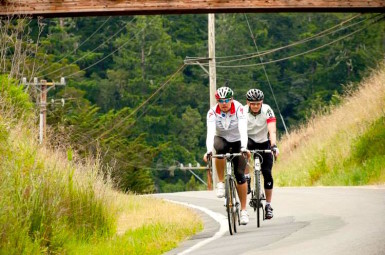Stop-As-Yield Among Bills Pushed to 2018 Busy Year for Bicycling Legislation in Sacramento
MCBC has been closely tracking developments in Sacramento that could have major impacts on bicycling infrastructure and enforcement. Two key pieces of legislation are Senate Bill 1 (SB 1), a gas tax and vehicle registration fee increase that will provide transportation funds, and Assembly Bill 1103 (AB 1103), which would legalize the safe cycling behavior of yielding at stop signs. The status of these state bills and others are detailed below.
SB 1 – Transportation Funding
SB 1, which will result in California’s first gas tax increase in 23 years, was widely reported as a fix for California’s crumbling roadways. Fortunately, the bill also promises to increase state funds for new walking and biking projects to $100 million annually, and increase money available for sustainable transportation planning efforts by $25 million annually. These monies are currently distributed via extremely competitive grants, so the increases should improve Marin’s chances of accessing some of these elusive funds.
The County of Marin and individual cities are estimated to receive $8.5 million for local road improvements beginning with the 2018/19 fiscal year, nearly doubling what they currently receive from gas taxes. This is great news for bicycling improvements – in addition to providing smoother rides on worn roads, this will allow public works departments to implement planned bicycle and pedestrian improvements as part of repaving projects.
MCBC will continue to monitor road maintenance projects to ensure bicycling improvements are incorporated where possible.
Status: Passed and signed by Governor Brown.
AB1103 – Bicycling Yielding
It’s something many of us do everyday: slow as we approach stop signs, scan for oncoming traffic, and roll through slowly if no cars or pedestrians are present in order to maintain our momentum. This bipartisan bill put forward by a Republican from Southern California and Democrat from San Francisco would legalize the practice of treating stop signs as yield signs while bicycling.
The bill faced its first test on May 8 in the Assembly Transportation Committee, where it was decided that it should be delayed until 2018 in order to give supporters more time to gather data to address the Committee’s concerns.
Status: To be reconsidered in 2018.
SB760 – Complete Streets
As we noted back in March, Caltrans has some ambitious goals to improve walking and bicycling in California. Senator Scott Wiener wants to hold the department accountable toward these goals through SB 760, which would require Caltrans to incorporate “complete streets” (walking and bicycling) improvements as part of their routine maintenance projects. In other words, as Caltrans engineers put the finishing touches on a road repaving project, they would also have to look for opportunities to create better bike lanes, safer crosswalks, etc. where possible.
The bill would also establish a new Division of Active Transportation to monitor the department’s progress as it works to make walking and bicycling safer on and across state highways.
Status: To be reconsidered in 2018.
AB694 – Full Lane for Safety Act
Under California Vehicle Code 21202, people bicycling must remain as close as practicable to the right-hand curb or edge of the roadway, except when overtaking another bicycle, preparing for a left turn, avoiding hazards, or approaching a right turn lane. Unfortunately, it’s often enforced by officers without an adequate understanding of the exceptions to the rule.
AB 694 would not necessarily change the legality of “taking the lane,” but rather clarify these rules. Richard Masoner at Cyclelicious offered the following on the problem with the current enforcement of CVC 21202:
The law contains a list of exceptions which includes a “substandard lane width” clause, but the abridged vehicle code cheat sheet used by California law enforcement agencies does not contain these exceptions, and side-of-the road appeals to the actual law or to common sense (“There’s literally not enough passing room!”) are often met with a response of “Take it the judge.”
The bill’s proposed wording also clarifies that slower-moving cyclists riding in right-hand lanes wide enough for bicycles and vehicles to travel safely side by side must stay to the right in order to allow vehicles to pass, absent hazards or turns.
Status: To be reconsidered in 2018.
AB 342 – Automated Speed Enforcement
Speeding drivers kill thousands of people per year, so it would make sense to do everything at our disposal to stop people from speeding, right? Cities that enforce speed with cameras have found it to be one of the most effective, quick, and easy-to-implement solutions.
Unfortunately, automated enforcement is illegal in California. This proposal would have created five-year automated speed enforcement pilot programs in San Francisco and San Jose, but did not have the support needed to move forward this year.



